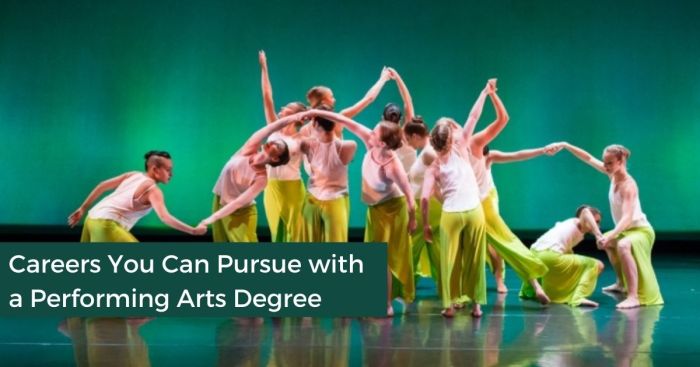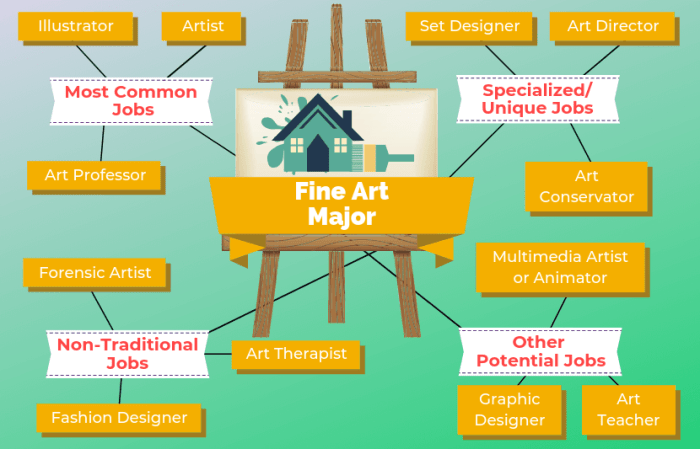
Embark on a journey through the world of performing arts degree career opportunities, where creativity and passion intersect to create endless possibilities for individuals seeking a unique and fulfilling professional path.
Discover the diverse avenues available for those with a performing arts degree, from traditional roles to innovative freelance opportunities that showcase the versatility and adaptability of this field.
Career Opportunities in Performing Arts Degree
Performing arts degree opens up a plethora of career opportunities for individuals passionate about the arts and entertainment industry. Let’s explore some of the potential paths for graduates in this field.
Various Career Paths
- Acting: Performing on stage, in films, television, or commercials.
- Dancing: Working as a professional dancer in a company, theater, or as a choreographer.
- Directing: Overseeing the artistic vision of a performance, film, or show.
- Theatre Production: Managing the technical and logistical aspects of a theatrical production.
- Arts Administration: Working behind the scenes in arts organizations, managing budgets, marketing, and operations.
Industries for Employment
- Theatre Companies: Joining established theater companies as actors, directors, or production crew members.
- Film and Television: Participating in film and television productions as actors, dancers, or choreographers.
- Event Management: Organizing and managing artistic events, festivals, and performances.
- Education: Teaching performing arts in schools, colleges, or as private instructors.
Freelance Work Potential
Performing arts graduates also have the option to work as freelancers, taking on various projects independently. This includes performing at events, teaching workshops, choreographing dances, or providing voiceover work for commercials and animations.
Application of Skills in Non-Traditional Settings
- Corporate Training: Using acting and improv skills to enhance communication and teamwork in corporate settings.
- Therapeutic Settings: Applying drama therapy techniques to help individuals overcome challenges and express themselves creatively.
- Public Speaking: Utilizing stage presence and vocal techniques to become effective public speakers and presenters.
Painting in Performing Arts

Painting plays a crucial role in the world of performing arts, enhancing the visual aspects of performances and theatrical productions. It brings a unique dimension to storytelling and helps convey emotions and messages to the audience in a powerful way.
Intersection of Painting and Performing Arts
Painting and performing arts intersect in various ways, with artists using visual elements to enhance the overall experience for the audience. From set designs to costumes, paintings can set the mood, time period, and atmosphere of a performance, creating a more immersive and engaging experience for viewers.
Enhancing Performances with Painting
- Paintings can be used as backdrops or projections during performances, adding depth and dimension to the stage.
- Artists can create custom paintings to be incorporated into costumes, adding a unique and artistic flair to the characters.
- Live painting performances can also be integrated into theatrical productions, providing a dynamic and interactive element to the show.
Famous Painters Influencing Performing Arts
- Pablo Picasso: Known for his cubist style, Picasso’s innovative approach to art has influenced set designs and costumes in various theatrical productions.
- Vincent van Gogh: Van Gogh’s expressive use of color and texture has inspired many artists in creating visually stunning backdrops and stage designs.
- Salvador Dali: Dali’s surrealistic paintings have been a source of inspiration for many avant-garde performances, pushing the boundaries of traditional art forms in the performing arts.
Role of Visual Elements in Conveying Emotions
Visual elements, such as paintings, play a significant role in conveying emotions in performing arts. The use of colors, shapes, and textures can evoke specific feelings and enhance the overall impact of a performance. By integrating paintings into theatrical productions, artists can create a visually captivating experience that resonates with the audience on a deeper level.
Philosophy in Performing Arts

Philosophy plays a crucial role in shaping the landscape of performing arts, influencing performances, and impacting society through ethical considerations.
Connection between Philosophy and Performing Arts
Philosophy and performing arts share a deep connection as both disciplines explore fundamental questions about existence, reality, and human experience. Philosophical concepts such as aesthetics, ethics, and metaphysics often inform the themes, narratives, and artistic choices in performances.
Philosophical Concepts Influence on Performances
-
Philosophical concepts like existentialism, idealism, and phenomenology can inspire innovative and thought-provoking performances that challenge traditional norms and perspectives.
-
The exploration of philosophical themes in performances can lead to introspection, critical thinking, and emotional engagement among audiences.
-
Performers often draw inspiration from philosophical theories to create impactful and meaningful artistic expressions that resonate with the human experience.
Role of Ethics in Performing Arts and Impact on Society
-
Ethics in performing arts guide decisions related to representation, cultural sensitivity, and social responsibility, ensuring that performances uphold moral and ethical standards.
-
Performing arts have the power to shape societal values, challenge perceptions, and promote empathy, making ethical considerations essential in creating socially relevant and inclusive performances.
-
By addressing ethical dilemmas and promoting ethical behavior, performing arts contribute to a more conscious and compassionate society.
Key Philosophical Theories Shaping Performing Arts Landscape
-
Theories like postmodernism, existentialism, and feminism have revolutionized the performing arts by introducing new perspectives, deconstructing traditional narratives, and promoting diversity and inclusivity.
-
Philosophical concepts from Eastern traditions, such as Taoism and Buddhism, have also influenced performing arts by emphasizing harmony, balance, and interconnectedness in artistic expressions.
-
The integration of philosophical theories in performing arts enriches the cultural tapestry, fosters dialogue, and encourages critical reflection on complex societal issues.
Photography in Performing Arts
Photography plays a crucial role in capturing the magic of performing arts performances and promoting events. It allows us to freeze moments in time and convey the emotions and energy of live performances through visual storytelling.
Use of Photography in Capturing Performing Arts Performances
Photography in performing arts serves as a means to document and preserve the essence of live performances. It captures the movements, expressions, and interactions of performers on stage, providing a glimpse into the world of theater, dance, music, and other forms of performing arts.
Use of Photography to Promote Performing Arts Events
Photography is a powerful tool for promoting performing arts events. Stunning images of past performances can be used to create anticipation and excitement for upcoming shows. By showcasing the dynamic visuals of live performances, photography attracts audiences and generates interest in the arts.
Iconic Photographs in Performing Arts
Iconic photographs in performing arts history have immortalized legendary performances and performers. Examples include the captivating image of Mikhail Baryshnikov leaping across the stage, the dramatic stills from Broadway musicals like “The Phantom of the Opera,” and the iconic concert shots of rock legends like Jimi Hendrix.
Importance of Lighting and Composition in Photographing Performing Arts
Lighting and composition are essential elements in photographing performing arts. Proper lighting enhances the mood and atmosphere of the performance, while thoughtful composition frames the action and directs the viewer’s focus. By mastering the interplay of light and composition, photographers can capture the essence of live performances with depth and emotion.
Short Fiction in Performing Arts
Short fiction plays a crucial role in the world of performing arts, serving as a source of inspiration for various performances. Through the art of storytelling, short fiction pieces can evoke emotions, create vivid imagery, and explore complex themes that can be translated into compelling performances on stage.
Relationship between Short Fiction and Performing Arts
Short fiction and performing arts have a symbiotic relationship, with short stories providing a wealth of material for adaptation into theatrical productions, dance performances, and even musical compositions. The concise yet impactful nature of short fiction allows for a focused exploration of characters, settings, and narratives that can be brought to life on stage.
- Short stories often serve as the foundation for plays, helping to develop plotlines, characters, and dialogue that can engage audiences in a live performance setting.
- The emotional depth and thematic richness of short fiction can inspire choreographers to create dance pieces that explore complex human experiences and relationships.
- Music composers may draw inspiration from the themes and moods present in short stories to create original scores that enhance the overall atmosphere of a performance.
Examples of Short Fiction Adapted into Successful Performances
Numerous short fiction pieces have been successfully adapted into performances that have captivated audiences around the world. One notable example is Truman Capote’s “Breakfast at Tiffany’s,” which was adapted into a popular stage play and later a beloved film. The intriguing characters and compelling storyline of the original short story translated seamlessly to the stage, captivating audiences with its timeless charm.
Use of Narrative Techniques from Short Fiction in Creating Performances
The narrative techniques employed in short fiction, such as character development, plot structure, and thematic exploration, serve as valuable tools for creating compelling performances in the realm of performing arts. By utilizing these techniques, performers can engage audiences on a deep emotional level, immersing them in the world of the story and leaving a lasting impact.
- Character development in short fiction can inform the physicality, emotions, and motivations of performers, helping them bring authenticity and depth to their roles on stage.
- The structure of a short story, with its clear beginning, middle, and end, can guide the pacing and progression of a performance, ensuring a cohesive and engaging experience for the audience.
- Thematic exploration in short fiction can inspire directors, choreographers, and designers to create visually stunning and intellectually stimulating performances that resonate with audiences long after the final curtain falls.
Visual Graphic Arts in Performing Arts
Visual graphic arts play a crucial role in enhancing performing arts productions by adding a visual element that complements the overall performance. From promotional materials to set design, graphic design principles are applied to create captivating visuals that engage and entice the audience.
Role of Visual Graphic Arts in Enhancing Performing Arts Productions
Visual graphics are utilized in various aspects of performing arts to enhance the overall aesthetic appeal and convey the intended message of the production. Whether it’s designing promotional materials such as posters, flyers, and digital banners, or creating immersive set designs that transport the audience to different worlds, visual graphic arts are essential in creating a memorable and impactful experience for spectators.
Application of Graphic Design Principles in Promotional Materials
When creating promotional materials for performing arts events, graphic designers apply fundamental design principles such as balance, contrast, alignment, and hierarchy to ensure that the visuals effectively communicate the essence of the performance. Through the use of typography, color schemes, and imagery, promotional materials are designed to capture the attention of potential attendees and convey the mood and tone of the production.
Use of Visual Graphics in Set Design and Stage Production
In set design and stage production, visual graphics are used to create immersive environments that enhance the storytelling and bring the performance to life. From digital projections and backdrops to intricate prop designs and lighting effects, visual graphics play a crucial role in setting the scene and establishing the mood of the performance.
Contribution of Visual Graphic Arts to Overall Aesthetic Appeal
The use of visual graphic arts contributes significantly to the overall aesthetic appeal of a performance by adding depth, dimension, and visual interest to the production. Whether it’s through intricate costume designs, elaborate stage backdrops, or dynamic lighting effects, visual graphics help create a visually stunning and cohesive experience that captivates the audience and elevates the quality of the performance.
In conclusion, the realm of performing arts degree career opportunities is a vibrant tapestry of creativity, innovation, and endless potential. Whether you choose a path in painting, philosophy, photography, short fiction, or visual graphic arts, the doors to a fulfilling and dynamic career are wide open for those willing to explore and embrace the magic of the performing arts.
Top FAQs
What industries typically hire performing arts graduates?
Performing arts graduates can find employment in a wide range of industries, including theater, film, television, advertising, event planning, education, and more.
How can performing arts skills be applied in non-traditional career settings?
Skills such as creativity, collaboration, communication, and adaptability gained through a performing arts degree can be valuable in non-traditional settings like marketing, human resources, and even technology companies.
What role does philosophy play in shaping performances in the arts?
Philosophical concepts often influence the themes, narratives, and underlying messages portrayed in performing arts productions, adding depth and meaning to the creative expression.
How can short fiction inspire performances in the realm of performing arts?
Short fiction pieces often serve as a source of inspiration for performances by providing unique storylines, characters, and themes that can be adapted and interpreted creatively on stage.
Why is visual graphic arts important in enhancing performing arts productions?
Visual graphic arts contribute to the overall aesthetic appeal of performances by creating captivating promotional materials, enhancing set designs, and adding visual elements that elevate the audience’s experience.





